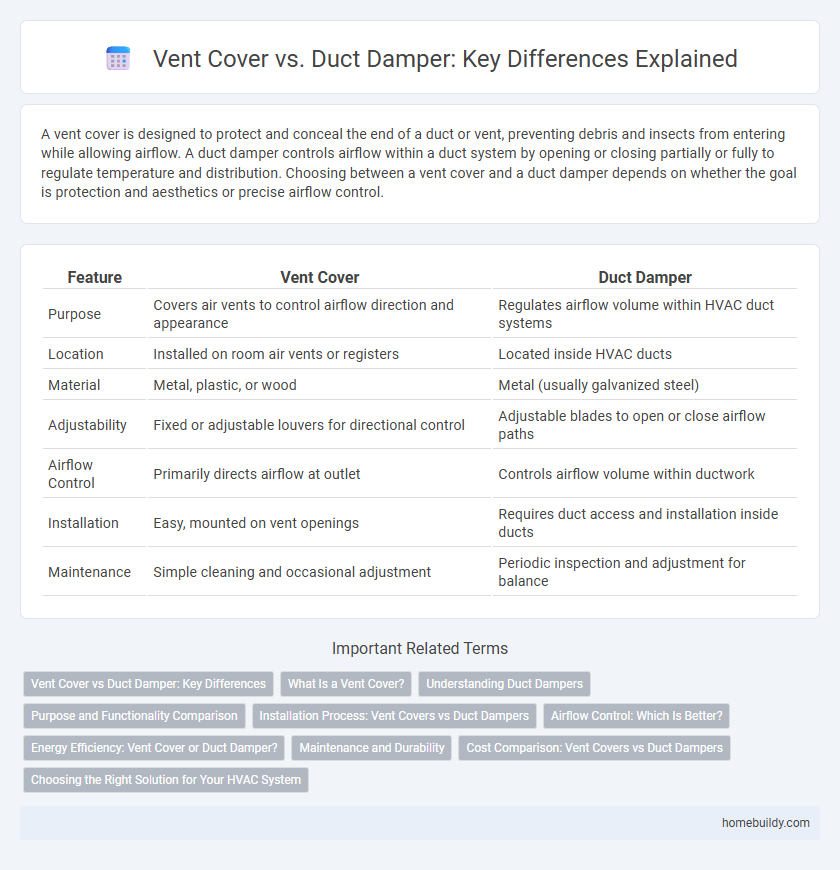A vent cover is designed to protect and conceal the end of a duct or vent, preventing debris and insects from entering while allowing airflow. A duct damper controls airflow within a duct system by opening or closing partially or fully to regulate temperature and distribution. Choosing between a vent cover and a duct damper depends on whether the goal is protection and aesthetics or precise airflow control.
Table of Comparison
| Feature | Vent Cover | Duct Damper |
|---|---|---|
| Purpose | Covers air vents to control airflow direction and appearance | Regulates airflow volume within HVAC duct systems |
| Location | Installed on room air vents or registers | Located inside HVAC ducts |
| Material | Metal, plastic, or wood | Metal (usually galvanized steel) |
| Adjustability | Fixed or adjustable louvers for directional control | Adjustable blades to open or close airflow paths |
| Airflow Control | Primarily directs airflow at outlet | Controls airflow volume within ductwork |
| Installation | Easy, mounted on vent openings | Requires duct access and installation inside ducts |
| Maintenance | Simple cleaning and occasional adjustment | Periodic inspection and adjustment for balance |
Vent Cover vs Duct Damper: Key Differences
Vent covers primarily serve to protect and conceal vent openings while allowing airflow, whereas duct dampers regulate and control the volume of air passing through ductwork. Vent covers are typically fixed and decorative, designed to prevent debris from entering vents, while duct dampers are adjustable components used to balance air distribution in HVAC systems. Understanding these differences helps optimize ventilation efficiency and maintain indoor air quality.
What Is a Vent Cover?
A vent cover is a protective grille or panel installed over air vents to regulate airflow and prevent debris from entering the duct system. Unlike duct dampers, which actively control the volume of air flowing through ducts, vent covers primarily serve as a physical barrier while contributing to overall ventilation efficiency. Vent covers are essential for maintaining air quality and improving the aesthetic appearance of HVAC systems.
Understanding Duct Dampers
Duct dampers control airflow within HVAC systems by regulating or blocking the passage of air through ducts, enhancing system efficiency and balancing room temperatures. Unlike vent covers, which primarily serve as protective and aesthetic coverings for vents, duct dampers provide functional control over air distribution. Proper installation and adjustment of duct dampers improve energy efficiency by directing airflow precisely where needed and preventing air leakage.
Purpose and Functionality Comparison
A vent cover primarily serves as a decorative barrier that prevents debris from entering air vents while allowing airflow, whereas a duct damper regulates and controls the air volume within HVAC ducts for efficient temperature distribution. Vent covers are fixed or removable screens designed for protection and aesthetic purposes, while duct dampers feature adjustable blades or mechanisms to modulate airflow. Understanding these functional distinctions is essential for optimizing ventilation system performance and indoor air quality.
Installation Process: Vent Covers vs Duct Dampers
Vent covers install quickly by snapping or screwing into existing vent openings, requiring minimal tools and no duct access. Duct dampers need more complex installation involving access to ductwork, cutting, and fitting the damper inside the duct to control airflow. The simpler installation of vent covers makes them ideal for quick upgrades, while duct dampers provide precise airflow control but demand professional handling.
Airflow Control: Which Is Better?
Vent covers primarily serve to protect ducts and improve aesthetic appeal, whereas duct dampers offer precise airflow control by regulating air volume through adjustable blades. For optimal airflow management in HVAC systems, duct dampers outperform vent covers due to their ability to balance and direct airflow efficiently. Choosing duct dampers enhances energy efficiency and comfort by allowing customization of air distribution in different zones.
Energy Efficiency: Vent Cover or Duct Damper?
Vent covers help improve energy efficiency by sealing unused vents, preventing heat loss or gain and reducing HVAC workload. Duct dampers regulate airflow within ducts, allowing precise control over heating and cooling distribution, which can optimize system performance and reduce energy waste. Choosing between vent covers and duct dampers depends on whether the priority is shutting off airflow entirely or balancing temperature and airflow in different zones.
Maintenance and Durability
Vent covers require minimal maintenance and are designed to withstand dust and debris exposure, ensuring long-lasting performance. In contrast, duct dampers contain moving parts that need regular inspection and lubrication to prevent mechanical failure. Choosing a high-quality vent cover enhances durability by reducing wear and maintenance demands compared to duct dampers.
Cost Comparison: Vent Covers vs Duct Dampers
Vent covers generally cost less than duct dampers due to simpler design and materials, making them a budget-friendly option for basic airflow control. Duct dampers, with adjustable mechanisms and enhanced airflow regulation, involve higher upfront expenses but can improve energy efficiency and system performance. Choosing between them depends on balancing initial cost with long-term HVAC efficiency needs.
Choosing the Right Solution for Your HVAC System
Vent covers and duct dampers serve distinct roles in HVAC systems, with vent covers primarily controlling airflow at the room level while duct dampers regulate airflow within the ductwork. Selecting the right solution depends on your system's ventilation needs, energy efficiency goals, and ease of installation. For precise airflow control and zoning, duct dampers offer superior flexibility, whereas vent covers provide a simpler, cost-effective option for basic airflow adjustment.
vent cover vs duct damper Infographic

 homebuildy.com
homebuildy.com